 This is the third part of a five part tutorial that will show you how to install a full featured email server on your Raspberry Pi. This tutorial covers how to set up Webmail with Squirrelmail.
This is the third part of a five part tutorial that will show you how to install a full featured email server on your Raspberry Pi. This tutorial covers how to set up Webmail with Squirrelmail.
The parts are:
The Introduction & Contents Page (read first)
Raspberry Pi Email Server Part 1: Postfix
Raspberry Pi Email Server Part 2: Dovecot
Raspberry Pi Email Server Part 3: Squirrelmail
Raspberry Pi Email Server Part 4: Spam Detection with Spamassassin
Raspberry Pi Email Server Part 5: Spam Sorting with LMTP & Sieve
Installing Apache
If you don't already have apache installed (you might if you've followed my wordpress tutorial), then install it now.
sudo apt-get update sudo apt-get install apache2
Enable the SSL apache module so that you can use HTTPS:
sudo a2enmod ssl
There are some "pre-made" virtualhost configurations that come with apache. This command will enable the "default-ssl" virtualhost, by creating a symbolic link from /etc/apache2/sites-available/default-ssl to /etc/apache2/sites-enabled/default-ssl:
sudo a2ensite default-ssl
Now reload apache to make the changes take effect:
sudo service apache2 reload
If you type the IP address or hostname of the pi into a web browser now, you should see the default Apache test page:  If you try the https version, you'll get a certificate error because you are using a self-signed SSL certificate. If you like, you can follow my CAcert tutorial to get a free SSL certificate for your domain, or you can just store an exception for the certificate and generate a proper one later.
If you try the https version, you'll get a certificate error because you are using a self-signed SSL certificate. If you like, you can follow my CAcert tutorial to get a free SSL certificate for your domain, or you can just store an exception for the certificate and generate a proper one later.  That's it for Apache. If you want to know more about setting up Apache for multiple websites, subdomains, and SSL configurations, I suggest you read my tutorial explaining Apache's VirtualHost files.
That's it for Apache. If you want to know more about setting up Apache for multiple websites, subdomains, and SSL configurations, I suggest you read my tutorial explaining Apache's VirtualHost files.
Installing Squirrelmail
Now we need to install squirrelmail:
sudo apt-get update sudo apt-get install squirrelmail
The basic configuration for squirrelmail is really easy, and can be done with the setup script. To run the script, use this command:
sudo squirrelmail-configure
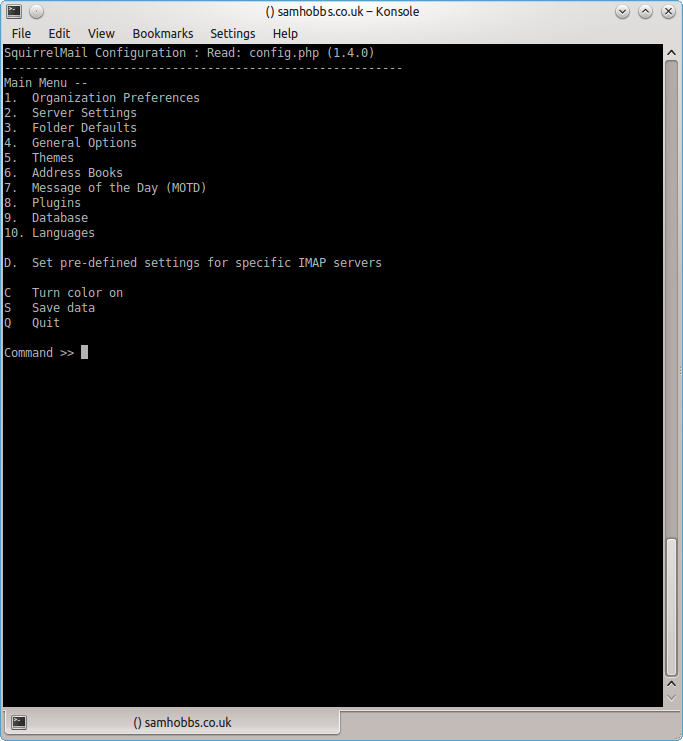 Choose “D” for pre-defined settings
Choose “D” for pre-defined settings 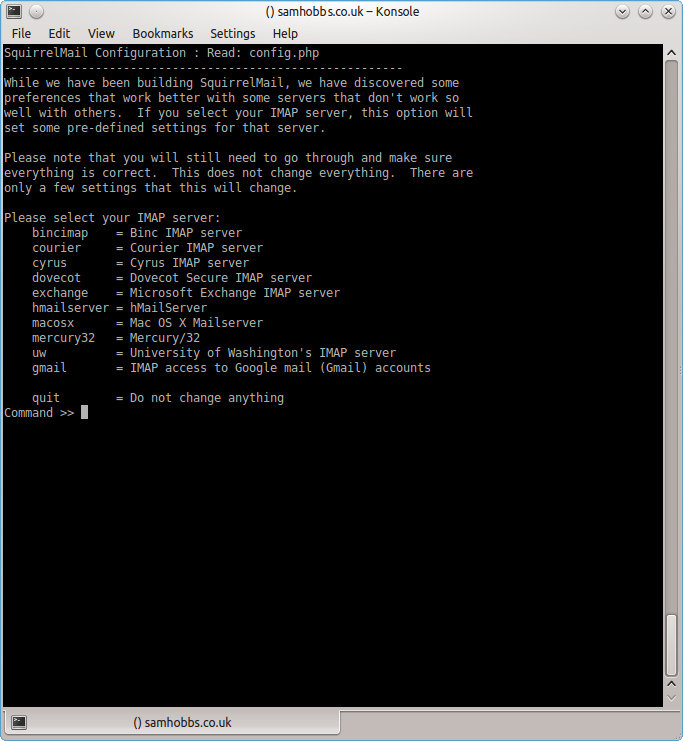 Now type “dovecot” and hit enter
Now type “dovecot” and hit enter 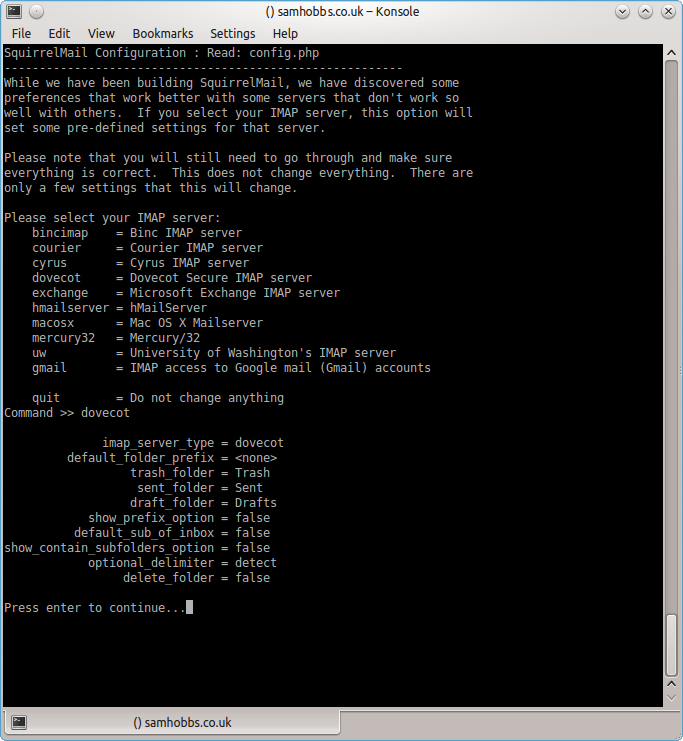 Press enter to continue, then save and quit (press Q and save when prompted, or press S then Q). The configuration script creates a configuration file for apache in
Press enter to continue, then save and quit (press Q and save when prompted, or press S then Q). The configuration script creates a configuration file for apache in /etc/squirrelmail/apache.conf. You need to create a symbolic link so that Apache2 will load your Squirrelmail apache configuration file when it starts up. On Raspbian Wheezy, the command is:
sudo ln -s /etc/squirrelmail/apache.conf /etc/apache2/conf.d/squirrelmail.conf
On Raspbian Jessie, the apache configuration directory structure is more like ubuntu, with separate folders for configuration files that are available and files that are enabled. This command will create a symlink from the directory where enabled configuration is stored, to squirrelmail's apache configuration file:
sudo ln -s /etc/squirrelmail/apache.conf /etc/apache2/conf-enabled/squirrelmail.conf
On a related note, there's a convenience command a2enconf that works similarly to a2ensite: it creates a symlink from the conf-available directory to the conf-enabled directory. You should use this in situations where config already exists in conf-available, e.g. sudo a2enconf squirrelmail would create a symlink for a file called squirrelmail.conf. Now reload Apache one more time so that it reads the config file we just symlinked:
sudo service apache2 reload
Now visit the IP address or hostname of your Pi again, but add /squirrelmail to the path, e.g. 192.168.1.174/squirrelmail, you should see the login page: 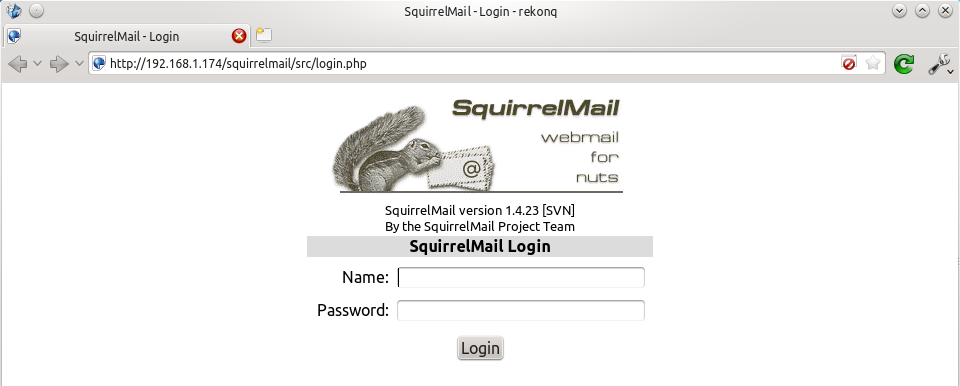 The squirrelmail configuration file just adds an alias that should affect every virtualhost, so if you install a wordpress site or something like that on your pi, you will be able to get to the squirrelmail login page by visiting yourdomain.com/squirrelmail.
The squirrelmail configuration file just adds an alias that should affect every virtualhost, so if you install a wordpress site or something like that on your pi, you will be able to get to the squirrelmail login page by visiting yourdomain.com/squirrelmail.
Redirect http to https for secure login
Since you don't want to send your login details and confidential information over the internet without SSL, it's best to redirect all http URLs to https. The default squirrelmail apache configuration file at /etc/squirrelmail/apache.conf contains some rewrite rules we can use, we just need to uncomment them. Open the file and uncomment the lines by removing the # at the start of each so that it looks like this:
<IfModule mod_rewrite.c>
<IfModule mod_ssl.c>
<Location /squirrelmail>
RewriteEngine on
RewriteCond %{HTTPS} !^on$ [NC]
RewriteRule . https://%{HTTP_HOST}%{REQUEST_URI} [L]
</Location>
</IfModule>
</IfModule>
This configuration makes sure that the rewrite and ssl modules are enabled, and does nothing if they aren't. We already enabled the ssl module earlier, so all we need to do now is enable the rewrite module:
sudo a2enmod rewrite
And reload Apache:
sudo service apache2 reload
Now if you visit the HTTP page, you should be redirected to HTTPS.
Optional: Configuring Apache to serve Squirrelmail on a subdomain
If you would like to move the login page to the root of your domain (i.e. so that yourdomain.com would serve the login page for squirrelmail), or if you would like to serve it on a subdomain like mail.yourdomain.com, you can edit the configuration file. If not, you can skip this section. By default, this line in /etc/squirrelmail/apache.conf means that http://www.yourdomain.com/squirrelmail will load squirrelmail:
Alias /squirrelmail /usr/share/squirrelmail
If you would rather have webmail on a subdomain like mail.yourdomain.com then you could edit the /etc/squirrelmail/apache.conf file to look like this (comment out the rest):
<VirtualHost *:80>
DocumentRoot /usr/share/squirrelmail
ServerName mail.yourdomain.com
<Directory /usr/share/squirrelmail>
Options FollowSymLinks
<IfModule mod_php5.c>
php_flag register_globals off
</IfModule>
<IfModule mod_dir.c>
DirectoryIndex index.php
</IfModule>
# access to configtest is limited by default to prevent information leak
<Files configtest.php>
order deny,allow
deny from all
allow from 127.0.0.1
</Files>
</Directory>
</VirtualHost>
Note that if you want to serve mail on a subdomain, then that subdomain needs a DNS record, so edit your records with your DNS provider accordingly. However, the virtualhost code above only does HTTP. You also want an HTTPS virtualhost for the subdomain on port 443:
<IfModule mod_ssl.c>
<VirtualHost *:443>
DocumentRoot /usr/share/squirrelmail
ServerName mail.yourdomain.com
<Directory /usr/share/squirrelmail>
Options FollowSymLinks
<IfModule mod_php5.c>
php_flag register_globals off
</IfModule>
<IfModule mod_dir.c>
DirectoryIndex index.php
</IfModule>
# access to configtest is limited by default to prevent information leak
<Files configtest.php>
order deny,allow
deny from all
allow from 127.0.0.1
</Files>
</Directory>
ErrorLog ${APACHE_LOG_DIR}/error.log
LogLevel warn
CustomLog ${APACHE_LOG_DIR}/ssl_access.log combined
SSLEngine on
SSLCertificateFile /etc/ssl/certs/your-ssl-certificate.crt
SSLCertificateKeyFile /etc/ssl/private/your-ssl-certificate-keyfile.key
</VirtualHost>
</IfModule>
If you use this configuration, the rewrite rules from the "rewrite to HTTPS" section (the ones from the default config file) won't work. If you want an HTTPS-only solution, you can replace the virtualhost for port 80 with this:
<VirtualHost *:80>
ServerName mail.yourdomain.com
<IfModule mod_rewrite.c>
<IfModule mod_ssl.c>
<Location />
RewriteEngine on
RewriteCond %{HTTPS} !^on$ [NC]
RewriteRule . https://%{HTTP_HOST}%{REQUEST_URI} [L]
</Location>
</IfModule>
</IfModule>
</VirtualHost>
As before, make sure you have the rewrite module enabled:
sudo a2enmod rewrite
Now reload apache:
sudo service apache2 restart
If you get an error like this:
[....] Restarting web server: apache2[Fri Dec 06 15:54:04 2013] [warn] _default_ VirtualHost overlap on port 443, the first has precedence
Then add NameVirtualHost *:443 to the start of the SSL VirtualHost block, i.e.:
NameVirtualHost *:443 <IfModule mod_ssl.c> <VirtualHost *:443> DocumentRoot /usr/share/squirrelmail ServerName mail.yourdomain.com ...
For more info on HTTP and HTTPS VirtualHost configuration on Apache2, see this tutorial of mine. If all went to plan then you can navigate to mail.yourdomain.com and you should see the squirrelmail login page (you might need to forward some ports on your router if you haven't already - see the next section): 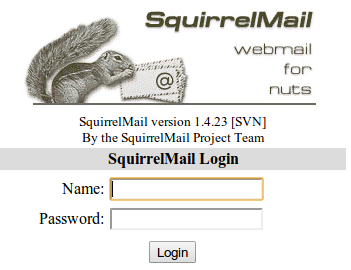
Port Forwarding
Squirrelmail will log in to your IMAP server on port 143 to display your emails. It doesn’t need to authenticate because it’s in your network (remember the permit_mynetworks parameter from the previous tutorials?). You don’t need to worry about it being an unencrypted connection, because the data isn't actually travelling over any insecure networks (the connection is internal). Similarly, you don’t need to open port 143 (“plain” imap without SSL/TLS) on your router because the connection happens within the Pi, and the content is actually served to you, the user, on port 443 (https). So you do need to open ports 80 and 443 for http and https like below: 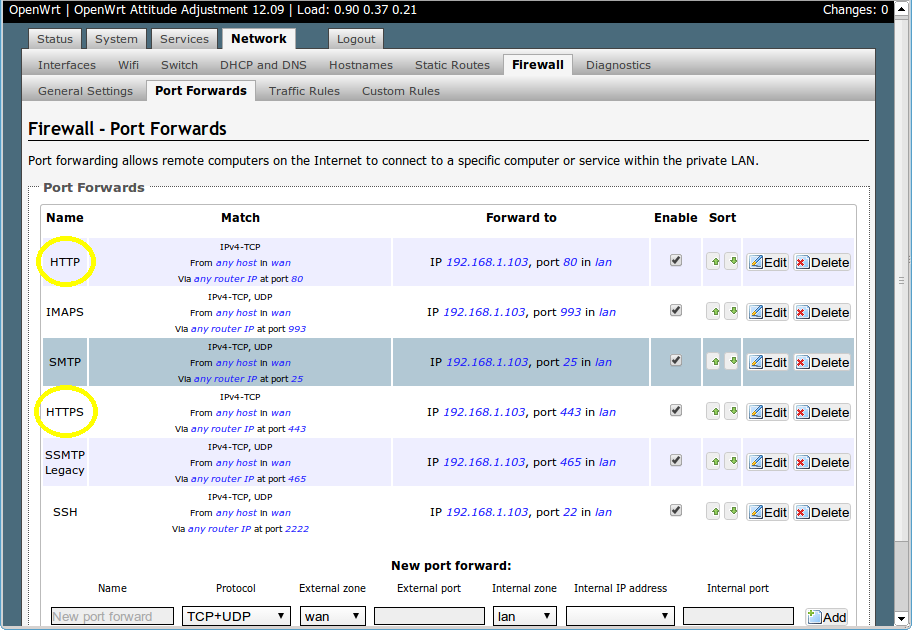
Testing
Before you start testing your webmail, make sure that the permit_mynetworks parameters are uncommented in your postfix confuguration file /etc/postfix/main.cf (in both your smtpd_recipient_restrictions and smtpd_helo_restrictions). Now reload your postfix configuration:
sudo service postfix reload
Try sending and receiving emails from within Squirrelmail. You should have no problems, but if you do please post a comment and I’ll try to help you out.
Customising the Squirrelmail Login
To customise the login page, run the configuration wizard:
sudo squirrelmail-configure
- Select “1″ (organisation preferences)
- Select “7″ and change to your domain (e.g. http://www.samhobbs.co.uk)
- Select “8″ and change to you/your organisation’s name
Squirrelmail Plugins
There are loads of plugins available for Squirrelmail, for all kinds of things. On most systems, these plugins are installed by downloading a .zip file to your server, unzipping the plugin to the right location and then tinkering with the settings manually. Thankfully, some of the most commonly used plugins are available from the Raspbian repositories, so installation is much simpler. Here is a list of the plugins in the repo:
- squirrelmail-compatibility
- squirrelmail-decode
- squirrelmail-locales
- squirrelmail-lockout
- squirrelmail-logger
- squirrelmail-quicksave
- squirrelmail-secure-login
- squirrelmail-sent-confirmation
- squirrelmail-spam-buttons
- squirrelmail-viewashtml
The one I think is most useful and the one I’m going to use as an example is lockout. To use the lockout package, we need to install the compatibility package, which basically makes sure that plugins built for different versions of squirrelmail can still work with the version you are running.
sudo apt-get update sudo apt-get install squirrelmail-compatibility
Now we need to enable the plugin:
sudo squirrelmail-configure
- select “8″
- select “compatibility”
- select “S” (to save)
- select “Q” (to quit)
That’s all you need to do for the compatibility plugin. Now we can install the lockout plugin:
sudo apt-get install squirrelmail-lockout
Now for the configuration:
sudo squirrelmail-configure
Make sure that lockout is enabled Now we can manually edit some settings. Before starting, I like to back up the default config files for reference:
cd /etc/squirrelmail sudo cp lockout-table.php lockout-table.php.BAK sudo cp lockout-config.php lockout-config.php.BAK
Now edit the lockout-table.php file. Read the comments in the file for an explanation of how the table works. I wanted to disable logins for the user “admin”, so I commented out the examples at the end of the file and replaced them with this:
user: admin locked_out.php
Now edit lockout-config.php and set $use_lockout_rules = 1; to turn on lockouts. Now try and log in as the user you locked out, and you should get this message: “Access Denied / Please contact your system administrator”. We can also lock out IP addresses of users who enter incorrect username/password combinations repeatedly. To do this, open lockout-config.php and set $max_login_attempts_per_IP = '3:5:0'. The first number in this parameter is the number of incorrect attempts that are allowed before a ban. The second number is the time frame for these incorrect attempts, and the last number is the amount of time the ban lasts for when activated (0 is forever). So, the setting I gave you above means that anyone who makes 3 incorrect attempts to authenticate in 5 minutes is permanently banned. When a successful login is made, the count is reset to 0. Data on current bad login attempts and bans is stored here: /var/lib/squirrelmail/data/lockout_plugin_login_failure_information The plugin will add entries like this to keep track of bad logins:
999.999.99.99_login_failure_times=1386774015:1386774034:1386774053 999.999.99.99_TOO_MANY_FAILED_LOGIN_ATTEMPTS=PERMANENT
…where 999.999.99.99 is the offending IP address If you accidentally ban yourself, you’ll have to log in via SSH and edit this file to remove those lines. That’s it, you’re done! Have fun exploring the other plugins! The next two tutorials, Part 4 and Part 5 deal with spam detection and filtering.
Comments
Squirrel main
Hi Sam,
Now I am getting something different. I must have broken something. This is my sq.../apache.conf Is this correct? At the moment I get a 404 error: The requested URL /squirrelmain was not found on this server after: www.mydomain/squirrelmain
Nothing in error.log. It seems to be looking only in /var/www/html where squirrelmain does not exist.
Alias /squirrelmail /usr/share/squirrelmail
<Directory /usr/share/squirrelmail>
Options FollowSymLinks
<IfModule mod_php5.c>
php_flag register_globals off
</IfModule>
<IfModule mod_dir.c>
DirectoryIndex index.php
</IfModule>
# access to configtest is limited by default to prevent information leak
<Files configtest.php>
order deny,allow
deny from all
allow from 127.0.0.1
</Files>
</Directory>
So close!
Hi Sam, thanks for these tutorials, I've almost got everything working!
I've got two issues, however:
1. I can send and receive mail, but the likes of hotmail and gmail throw it back without delivering. I noticed you recommended to someone else to use their ISP's SMTP instead - how do you go about setting that up?
2. I can't get SquirrelMail to work on https, it gives me the error "Secure Connection Failed: ssl_error_rx_record_too_long". How do I fix it? (Webmin etc is working fine on https)
Thanks!
Security with users.
Hello Sam,
You have done a great job with this guide. Boy, that's a lot of work you've put there. Well done!
I have set up everything running smoothly so and I am very satisfied with my system overall. Those Pis can do so many things.
Anyway, I want to share my concerns about adding local users so they can mail as user@domain.com. I mean, any user you add, can just SSH to my pi, right? And even though they don't have sudo rights, they can still read everything in server. I thought maybe try to put them in groups and play with privileges but that will be so redundant for like 10 users. And virtual users doesn't seem like a solution for home users :p
You could use publickey authentication
I totally missed that guide
Thank you very much for your reply. Obviously I didn't see that guide about server preparation. I am going to have a look at it when I get back home.
Gmail says mails are not encrypted
Hello Sam,
I got another question that may help others too.
I set up everything according to your guide. Only thing I skipped was the PTR record since I don't have a static IP.
I sent an email to a friend and asked him to check it out. Unsurprisingly it was in spam folder. But when he clicked on that spam flag to check why it was flagged as spam, Gmail reported that "encryption: otenet.gr (my provider) did not encrypt this message". Does that mean that the message is not actually encrypted? Or just that my provider was not the one that encrypted the message, but someone else?
TLS settings
/etc/postfix/main.cf: Watch the logs and see what happens when you send a test email (tail -f /var/log/mail.log). SamThat worked!
I can confirm that above steps did work for me.
Not gmail says "encryption: Standard (TLS)"
Dovecot keeps logging in and out the user
Hello Sam,
First of all, amazing job on the tutorial. Props ! :D
I got it to work just fine, I was able to send and receive from an external email but after the first session of send/receive I could only send mail. Couldn't see the received emails anymore.
I checked the status of postfix and dovecot and the first thing that seemed wrong to me was the status of dovecot. He keeps logging and disconnecting the user for the mail. I couldn't find the cause for not receiving the mails anymore. Would it be possible to take a look into the matter ? :D
Below I posted a few lines from the mail log. (replaced the user with xxxx)
Please let me know if other records are needed.
Thanks a lot !
Mail.log :
Jul 15 11:07:51 pitesting101 dovecot: imap-login: Login: user=, method=PLAIN, rip=::1, lip=::1, mpid=7873, secured, session=
Jul 15 11:07:51 pitesting101 dovecot: imap(xxxx): Disconnected: Logged out in=292 out=1889
Jul 15 11:07:53 pitesting101 dovecot: imap-login: Login: user=, method=PLAIN, rip=::1, lip=::1, mpid=7878, secured, session=
Jul 15 11:07:53 pitesting101 dovecot: imap(xxxx): Disconnected: Logged out in=292 out=1889
Jul 15 11:07:54 pitesting101 dovecot: imap-login: Login: user=, method=PLAIN, rip=::1, lip=::1, mpid=7883, secured, session=
Jul 15 11:07:54 pitesting101 dovecot: imap(xxxx): Disconnected: Logged out in=79 out=728
that's normal
using SMTP Server from ISP
Hi Sam
1st: Some People here said if I can't send an E-Mail because of Blocking Reasons, I can use the SMTP-Server from my ISP. How can I do that, that also Squirrelmail uses there Server and not only Outlook or K9 Application?
2nd: I installed the Lockout Plugin and made the Settings in the Config-Files. But if I want to Log In with admin there comes this Error: The requested URL /plugins/lockout/locket_out.php was not found on this Server.
Is there something I missed?
Thanks
Luca
Hi again
Hi again
The 2nd Problem was a mistake. I accidently typed "locket" instead of "locked". So you can Forget the 2nd.
Hope to hear soon from you.
not sure, never had to do it.
php problem?
Here I am again - Mail is working fine, but I'm having trouble now with what I thought was the easy part - Squirrelmail. I've run it before, and I even had it running recently the first time through your great tutorial. However, I borked things and with the re-do, I have the mail server and spamassassin working fine, but I can't get squirrelmail going! The problem has been well-googled, but I didn't find definitive answers. If it's been covered in these comments, just let me know - I haven't read every single page of comments yet. Instead of the login page, I get:
ERROR: Config file ' . '"config/config.php" not found. You need to ' . 'configure SquirrelMail before you can use it.
'; exit; } // If we are, go ahead to the login page. header('Location: src/login.php'); ?>
This is AFTER running the squirrelmail-configure and choosing dovecot as instructed.
Do you know the fix? THANKS! - John
If you're seeing the source
php5
It's something like that. I have php5 installed. I enabled that with a2enmod, but that broke apache2 - now it won't restart. What I also don't understand is that I had squirrelmail working a couple of days ago, and since then I have not knowingly done anything with php5. Should I try reinstalling php5? I have remove --purge apache2 several times, but not anything with php5. Any further suggestions appreciated!
MY first time through the tutorial, when I got to squirrelmail, it went smoothly and as expected. Then I installed spamassassin, and that is fine. However, I then messed something up trying to get Sieve going and messed up Dovecot and had to start the whole process over. Doing that I did several "removes" of everything - squirrelmail, apache2, dovecot, and postfix. Maybe somewhere in there I lost something with php. I tried install php5, and it said I have the latest version. When I install squirrelmail, there are a couple of SUGGESTED php packages, but googling those didn't sound like they were critical - and squirrelmail would've installed them if they were.
(The really good news is that I do have an image of my working server on another SD card, so I can play with one instance all I want without risking having to start from the beginning with the whole server.)
Squirrelmail - php5
I got it! It wasn't that php wasn't enabled in apache2, it was that my php wasn't working at all. I had removed and reinstalled php5 several times to no avail, but it turned out I needed to install libapache2-mod-php5. I don't know how I lost that long the way somehow, but installing it solved my problems!
Now I'm finally ready to work on getting Sieve going. The last time I had a server like this going, I used procmail with postfix, so I have no experience with Sieve, but it seems to be the choice of the day for sorting mail.
Thanks again! - John
Glad you found a solution :)
supertutor
I love your tutorials, very clear, straight forward and understandable for idiots like me, keep them coming! Thanks
Thanks!
Hi, first of all thank you
Hi, first of all thank you for this amazing tutorial. I am in testing phase, and I am able to send out emails, but I couldn't receive any. Here is the error message google sent back to me: "Google tried to deliver your message, but it was rejected by the server for the recipient domain xxx.com by smtp.secureserver.net. [72.167.238.29].
The error that the other server returned was:
550 5.1.1 Recipient not found. "
Could you help me out?
Thanks,
Junxian
Have you configured your DNS
tail -f /var/log/mail.logand see if there are any hints in the log. SamHi Sam,
Hi Sam,
Thanks for the fast reply!
I think the problem is I am using Amazon EC2 to host my website, and DNS is NOT configured correctly.
Could you walk me through how to do this?
Best,
Junxian Zhang
DNS basics tutorial
myhostnameparameter to your mail subdomain too, so the helo matches the DNS record. Samgetting relay access denied when sending from squirrelmail
When i try to send mail via Squirrelmail i get error 554 5.7.1 : Relay access denied
Thanks in advance for any help you can provide.
-Jeff
Did you check the log? Sam
Installing Apache
I've been at it for a few days now. Just hit a complete stop, even after uninstalling and purging
A few lines down from the top, after:
sudo apt-get update
sudo apt-get install apache2
sudo a2enmod ssl
sudo a2ensite default-ssl
sudo service apache2 reload
Job for apache2.service failed. See 'systemctl status apache2.service' and 'journalctl -xn' for details.
pi@raspberrypi:~ $ systemctl status apache2.service
● apache2.service - LSB: Apache2 web server
Loaded: loaded (/etc/init.d/apache2)
Drop-In: /lib/systemd/system/apache2.service.d
└─forking.conf
Active: inactive (dead) since Wed 2016-12-14 22:23:00 GMT; 2min 20s ago
pi@raspberrypi:~ $ journalctl -xn
No journal files were found.
I'd tear my hair out if I had any left....
I'd love to send all the config files, just tell me which ones.
Needless to say, I can't get my CACert to accept my hostname. Ho Hum..
Merry Christmas.
Try this to check the apache
Results
Thanks for replying. As luck would have it, I was staring dejectedly at the screen when the mail came in.
pi@raspberrypi:~ $ sudo apachectl configtest
[Thu Dec 15 14:14:05.434962 2016] [alias:warn] [pid 7934:tid 3069743632] AH00671: The Alias directive in /etc/apache2/sites-enabled/squirrelmail.conf at line 1 will probably never match because it overlaps an earlier Alias.
AH00558: apache2: Could not reliably determine the server's fully qualified domain name, using 127.0.1.1. Set the 'ServerName' directive globally to suppress this message
Syntax OK
pi@raspberrypi:~ $
pi@raspberrypi:~ $ sudo journalctl -u apache2
-- Logs begin at Thu 2016-12-15 06:50:12 GMT, end at Thu 2016-12-15 14:15:51 GMT. --
pi@raspberrypi:~ $
GNU nano 2.2.6 File: /etc/apache2/sites-enabled/squirrelmail.conf
Alias /squirrelmail /usr/share/squirrelmail
<Directory /usr/share/squirrelmail>
Options FollowSymLinks
<IfModule mod_php5.c>
php_flag register_globals off
</IfModule>
<IfModule mod_dir.c>
DirectoryIndex index.php
</IfModule>
# access to configtest is limited by default to prevent information leak
<Files configtest.php>
order deny,allow
deny from all
allow from 127.0.0.1
check for other config with an alias
/squirrelmail, or an enabled config file in/etc/apache2/conf-enabled/for squirrelmail that you're not using? You can delete/disable stuff in theconf-enabledfolder usingsudo a2disconf foowhere the config file isfoo.conf, which leaves the file in/etc/apache2/conf-available/but removes the symlink intoconf-enabledso the config file isn't loaded. Thejournalctlcommand (with -xn) will only show you the last 10 lines of the log, which is useful right after you have an error but not if you leave it for a while and then try it since it might be showing unrelated lines - this is why I gave you the command with-u apache2, which filters for messages related to apache (although you might want to try apache instead of apache2, since it didn't yield any results - I can't remember what the unit file is called). SamAdd new comment